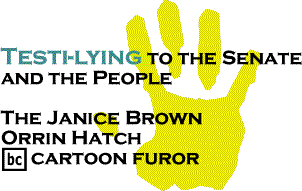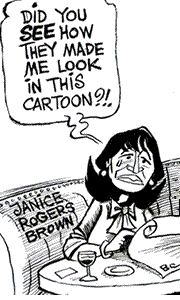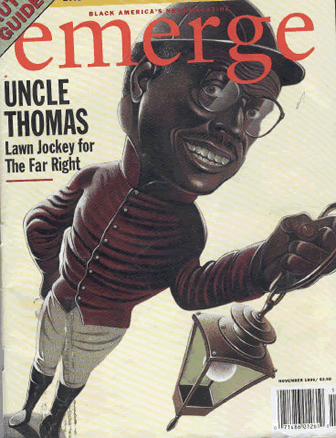
|
|||||||||||||||||||||
|
Orrin Hatch couldn’t care less whether he brought fame or ignominy to an online Black political journal. The Utah Republican was gunning for much bigger game. In one brief morning and afternoon session, he bum rushed and demoralized the Democratic minority on the Judiciary Committee, transformed a Hard Right ideologue into the very picture of victimized, long-suffering, near-to-weeping Black womanhood, and threw much of progressive America into head-shaking consternation.
Click to view entire Janice Rogers Brown Cartoon In the process, Hatch brought the judicial nomination process into disrepute by purposefully disrupting the hearing through his own orchestrations. Hatch violated the spirit and implicit trust of the Senate. In full view and command of television cameras, Chairman Hatch lied to the public and his colleagues and caused a prospective federal judge to also lie.
The
Black Commentator was the surprise witness in the hearing room – our
cartoon, exhibit A. A drawing by an immigrant artist, commissioned by men representing no one but their own publication, an item of absolutely no relevance to the business before the committee, was made to dominate a critical process of the United States Senate: its duty to advise and consent.
The crying time
“I was not going to bring up that cartoon, but since a lot of people have, there’s something I would like to say.” Janice Rogers Brown wore the face she would present to the cameras throughout the day: hurt, fragile, one harsh word away from tears. Directly in her field of vision stood a poster-sized version of the cartoon that had so wounded her, mounted on an easel, captioned: “Bush nominates Clarence-like conservative to the court.” Not too far away, a TV monitor displayed the BlackCommentator.com cartoon web page. All the props were in order, including the human one: herself. Yet Brown feigned surprise that the cartoon was the primary exhibit of the hearing, or that she might be called upon to comment on the drawing. Incredibly, she claimed to have only learned of the existence of the cartoon the day before, in a telephone conversation with her assistant, who was “choking back tears” at the “horrible things” that “they’ve done” to Brown. “I had not seen the cartoon,” she told the Senators and the cameras.
Click to view entire Female Clarence Cartoon Brown disrespects public
intelligence, her oath and her profession. The Hatch Cartoon
Show had been in pre-production for weeks, ever since the September
4 issue of However,
it is inconceivable that Brown was unaware of Orrin Hatch’s
feverish and highly public stage-setting in the wake of the
September 4 cartoon. Hatch and
his platoons approached every available source of publicity,
spreading the bare-assed lie that People for the American Way
and the NAACP had colluded with In the week before the
October 22 hearing, Hatch stepped up the pace of his To
give credence to Brown and Hatch one would have to accept that
the Republicans
sprang the same trap on their unwitting nominee that they had
devised for the Democrats and an innocent public. Cruel friends,
indeed. In that case, Brown would have reason to be more furious
at Hatch than “hurt” by But such was not the case. Brown played her assigned role in Hatch’s drama, lying on cue in the nation’s face. For a Bush judge, that’s a litmus test. Gone with the Windbag By the morning of the hearing, Hatch had seen enough of the cartoon to draw it himself in the dark. He and Republican Senators and committee staffers knew from repeated viewing that there were two Clarence Thomases positioned next to each other in the drawing, identical in every detail except clothing and hair. The bareheaded twin caricature in a judicial robe and tie, flanked on the right by Rice and Powell, was clearly labeled, “Clarence.” The wigged, unnamed twin in a female judicial robe could not possibly be anything but Clarence in drag – a political statement, and quite a funny one. No cognitively normal person would conclude that the twin caricature under the wig was the artist’s representation of the physical Janice Brown. Rather, it was the political Janice Brown, a creature just like Clarence. Orrin Hatch caused the audience to see a “mammy” that was not there.
Having planted the impression that Janice Brown is depicted in the cartoon as an archetypal fat “mammy” (what else could be cause for such a fuss?), Hatch then linked the Congressional Black Caucus with the cartoon’s “bigotry.”
Pennsylvania Republican Arlen Specter stated matter-of-factly that the fright wig figure was a caricature of Brown. “I hadn’t known what Justice Brown looked like before I saw the cartoon. Now that I see her it’s even a greater distortion than I anticipated.” Orrin Hatch kept grim
watch over his
Texas Republican John Cornyn made sure nobody messed with his chairman’s cartoon paraphernalia: “I for one hope that we keep that cartoon up during the remainder of this hearing. And I also hope we hear from this committee a denunciation of such low and unworthy tactics, certainly beneath the dignity of this body and, I believe, beneath any sort of semblance of civilized discourse.”
What logic! The cartoon is “beneath the dignity of this body” but Cornyn insists that it continue to be displayed “during the remainder of this hearing.” Cornyn later commiserated with Brown. “Sometimes during the course of these hearings I fear that the nominees become a symbol and perhaps a caricature.” Yet he demands that the hearing room and nation remain riveted on a cartoon full of caricatures! The
Republican’s purpose
in making a fetish of the cartoon was to disrupt the hearing,
itself. Orrin Hatch staged an utterly cynical, perverse assault
on a nomination process that occasionally frustrates the GOP’s
relentless packing of the judiciary with Hard Right lawyers. So
deep is Hatch’s contempt for constitutional processes, that
he gleefully sabotaged his committee’s lawful mission by imposing
on it Senator Ted Kennedy was knocked into state of pitiful incoherence: “As others have stated, the kind of cartoon that is displayed here and all that it suggests, and that, obviously, I have been on this committee for some number of years, and we have really been free from, uh, this kind of activity, suggestion. In more recent times some of the suggestions have been raised but, uh, it has no place, anyplace in our society, particularly not here.” What the hell did that mean? We recognize the obligatory denunciation at the end of the string of words, but what kind of “activity” and “suggestion” has the committee been free from for “some number of years?” Did Kennedy mean that in past years no chairman had foisted “offensive” cartoons on the committee? Was this a mumbled complaint against Hatch? Or did he mean that he had not seen such a cartoon in years? It doesn’t matter. Hatch had neutralized Kennedy. Hatch’s
cartoon hoo-doo managed to break the stride of the normally
forceful and businesslike
Democratic Senator from Illinois, Richard Durbin, who felt
compelled to thrash The “criticism” – that
is,
“Do you think it is fair for us to ask you what your position is on issues based on how you have ruled in past cases, and statements you have made in speeches,” Durbin said softly, like a pediatrician asking where it hurts. Brown gave her assent, still pretending to bat back tears that never came. Hatch succeeded in taking much of the wind out of the Democrat’s sails, and blamed it on his straw men at The Black Commentator. It has been suggested that the Democrats were sandbagged, caught by surprise, victimized, Hatch-whacked. This may be so, but does not explain or excuse their failure to protest the chairman’s mangling of the committee’s mission. The Black Commentator is not written for rich white Senators, although all are welcome to read it. They are free to denounce us all year long, and boost our numbers with every breath. But as much as we like the exposure, our cartoons are not fit exhibits for confirming federal judges. Every Senator in the hearing room knew that Hatch committed a grotesque abuse of his chairmanship, inflicting lasting injury on the Senate as an institution. Not one member stood up forcefully for the constitutional process. The cartoons should have come down, immediately, or remained only under the strongest protest. If all nine Democrats vote against Brown’s nomination, Democratic leaders may be willing to filibuster her confirmation, as they have three of Bush’s previous nominees. That’s what the Congressional Black Caucus has requested. But if one Judiciary Committee Democrat wilts, then Brown will be on her way to a seat on the nation’s most important appellate bench, a candidate to later join Clarence Thomas on the U.S. Supreme Court. Once together as lifetime colleagues, except for their physical characteristics, you will not be able to tell them apart. Mass media hallucination Mesmerized
by Hatch – or
simply seeing what they wanted or expected to see – the bulk
of the corporate press reported that “The cartoon shows Brown wearing a large Afro hairstyle and being greeted to the Bush administration by clapping caricatures of Justice Thomas, Secretary of State Colin Powell and national security adviser Condoleezza Rice,” said the October 23 San Francisco Chronicle. The nearby San Jose Mercury News got it half right, half wrong: “The cartoon showed an offensive caricature of Brown and described her as a female Clarence Thomas, the conservative black U.S. Supreme Court justice.” Charles Hurt, a reporter for the rightwing Washington Times, appears to have been inspired by both Hatch and the 1930s film, “Gone with the Wind.” “The cartoon, accompanying a statement by the liberal activist group People for the American Way, depicts Justice Brown with an enormous Afro hairdo and wearing the apron of a house servant.” Cartoonist Khalil Bendib is an accomplished artist who knows the difference between an apron and a judicial robe, as denoted by the black stripes on both the male and female Clarence’s clothing. But no one can defeat the demons of other people’s imaginations. (Readers of a sartorial bent may visit Bendib’s depiction of all nine assembled justices, in the March 6 commentary, “All About Clarence: Self-loathing on the High Court.” Note that Sandra Day O’Connor’s formal neckwear is identical to that worn by Clarence in drag, September 4.) MSNBC’s Tom Curry refused to recognize that the “buffoonish” Clarence Thomas and the “grotesque” Janice Brown were identical caricatures of – Clarence Thomas: “Justice Thomas himself was a graphic presence at the hearings in the form of a crude cartoon from a Web site called Black Commentator that showed Thomas, National Security Adviser Condoleezza Rice and Secretary of State Colin Powell as buffoonish figures applauding a grotesque caricature of Brown as Bush announced her nomination.” The Clarence Thomas is not appealing as a woman, in the real or cartoon worlds. But Janice Brown was nowhere to be found in the cartoon. The October 24 issue
of the liberal Mother
Jones magazine was afflicted with the same faulty, pre-determined
vision as its corporate antagonists. “The cartoon, which portrays
Brown as overweight and with a large "fright wig" on
her head, shows president Bush confusing her name with that
of Justice Clarence Thomas.” Interestingly, the only major corporate media that got the story right is published in Hatch’s mostly Mormon home state of Utah. Salt Lake City’s Deseret News reported: “Hatch showed the committee a cartoon from liberal BlackCommentator.com that depicts her as a female Clarence Thomas – the black, conservative U.S. Supreme Court justice. As fellow black conservatives Thomas, Colin Powell and Condoleezza Rice applaud in the cartoon, President Bush tells Rogers she will fit in well.” What would Jayson Blair do? Newspapers across
the nation ran the New
York Times account of the hearing. Washington correspondent
Neil A. Lewis telephoned and e-mailed
Lewis lied. Ford told Neil that any attempt by the Republicans to associate PFAW-NAACP
with authorship or placement of the cartoon is “just plain
wrong.” But the Timesman invented a crucial part of the
conversation, anyway. We can document from Neil’s email
that he contacted us believing Neil’s invention is much more serious than a simple misquote. It attempts
to shift the onus for Orrin Hatch’s guilt-by-association
campaign from the GOP to People for the American Way and the NAACP take the matter very seriously. Two days after the hearing, PFAW charged:
Black and progressive organizations and the elected officials they influence must come to grips with the double-pronged threat posed by appointees such as Janice Brown, Condoleezza Rice, Colin Powell, and Clarence Thomas.
Seen through one lens, these front persons for rich men’s policies are window dressing on a Republican set, placed there to provide a patina of “diversity” and “colorblindness” so as to make the GOP more palatable to white “moderates.” (There is no serious expectation among Republicans that masses of African Americans will be fooled into voting against their own interests – that’s a white American syndrome.) Under the Bush regime, the Right has brazenly usurped the vocabulary of civil rights in defense of their Black and brown hirelings. The Orrin Hatches of America, who have deservedly been called “racists” all their lives, discovered that there are plenty of African American opportunists eager jump into the very short Black line to Republican prominence. Now these white born-again diversifiers experience a kind of liberation in the belief that they are turning the rhetorical tables. They positively revel in labeling Black and white opponents of “their” Blacks as “racists” – as if to say, “back at ya!” Black America’s Most Hated Thus we confront an unprecedented political climate in which Hard Right whites are more likely to issue blanket, nonspecific charges of racism than the genuine Black militant – and with more sheer joy! The white American rightist loves his handful of special Blacks with the same intensity that he hates the great mass of the race.
However, this is a peculiarly white phenomenon, one that cannot cross to the other side of the tracks, where it is an incontestable and weighty fact that Clarence Thomas is the most hated Black man in Black America. Clarence Thomas is a living epithet, an incomparably negative association in the African American mind. He doesn’t need to be “uglied up”; his name and visage evoke revulsion. He is the personification of repugnance, an insult to a whole people, made more vicious by the sickly, ghoulish affection shown him by the most implacable foes of social justice.
Journalists speak in the language of their audiences; they send symbolic as well as literal messages that are often very specific to the group addressed. Republicans constantly employ anti-Black symbolic speech – code words are the ubiquitous subtext of the White Man’s Party.
Black folks also employ broadly understood symbols and codes. Political cartoons are heavily coded; some are pure code, and awesomely powerful, requiring no text at all. Emerge Magazine’s November, 1996 cover of Clarence Thomas as a lawn jockey was a cathartic, shared experience for African Americans. It held libraries of meaning.
George E. Curry was editor of Emerge, which was at the time the most prestigious Black news magazine in the nation. He’s now editor-in-chief of BlackPressUSA. Curry’s current piece, “Sen. Hatch Uses Cartoon as a Smokescreen,” speaks directly to the issue.
Black
people will decide if a cartoon designed for a predominantly
Black audience is “disgusting” or “bigoted” or “repugnant.” Political
cartooning, like political writing and all things political,
can be fractious and brutal. When a people are engaged in struggle
with a relentless, merciless enemy, those journals that purport
to defend the interests of the people must be zealous and unyielding.
If the commentator or cartoonist is tamer and milder than the
opposition, he has failed in his mission. If he goes beyond the
boundaries of expression that is acceptable to his audience,
he will be rejected. Orrin Hatch has nothing to do with it – nor,
for that matter, does Ted Kennedy.
Black America needs more Aaron McGruders, whose young protagonists speak from the very center of the African American worldview (while engaging phenomenal numbers of non-Blacks, as well). The Washington Post refused to run a week of Boondocks cartoons that humorously speculated on the relationship between Condoleezza Rice’s war mongering ways and her sex life. We say that the Washington Post is not fit to judge McGruder’s work.
Click to view complete Boondocks Strip Black America needs many more pens for writing and cartooning, including pens with poison tips. Without them, our political development is stunted, our ideas remain untested among the people, and our defenses against hostile manipulation, crumble. The Hard Right spends millions each week to finance its “alternative leadership” for Black America, mercenaries modeled on Thomas, Rice, Powell, and now, Janice Brown. Black people cannot keep these pretenders off the airwaves; we don’t control the media. We cannot by ourselves defeat their nominations on Capitol Hill; we don’t have the numbers. We can’t stop the rich from funding bogus Black front groups; it’s not our money. But we can heap scorn on the rascals, and thus deny them legitimacy as “spokespersons,” “leaders” and “role models” for our communities. We can confront them with our anger at every public and private opportunity, so that young people will think twice before considering a career in the enemy’s camp. We can stop giving them awards, or tolerating those who award them. We have the power to loudly reject the servants of Hatch and Bush and rich foundations, to expose their sources of funding and their true political allegiances. In the most egregious cases, we can render them pariahs, unwelcome and insecure among the people they have been paid to subvert. We have it in our power to devalue the “alternative” Blacks in the eyes of their benefactors, who are paying for influence among African Americans, not infamy. We can embarrass them, because they deserve it. We can draw cartoons that hold them up to ridicule – a small penalty for treachery. All of us would prefer to celebrate Black faces in high places. Intra-Black discord is painful to a people who have been shaped by a history in which unity and community were often our only assets. But a false unity based on race alone allows free reign to the stooges among us, creating conditions in which effective action becomes impossible. Sooner rather than later, every significant Black organization will have to confront the Right’s generously financed and highly sophisticated “alternative Black leadership” project. The California Association of Black Lawyers (CABL) found itself at that juncture, with the nomination of Janice Rogers Brown.
Sometimes you just have to call a Tom a Tom, and a Janice a Clarence. |
October 30,
2003 |
||||||||||||
|
||||||||||||
|
|
||||||||||||
| Printer Friendly Version | ||||||||||||
| |
||||||||||||
| |
||||||||||||





































